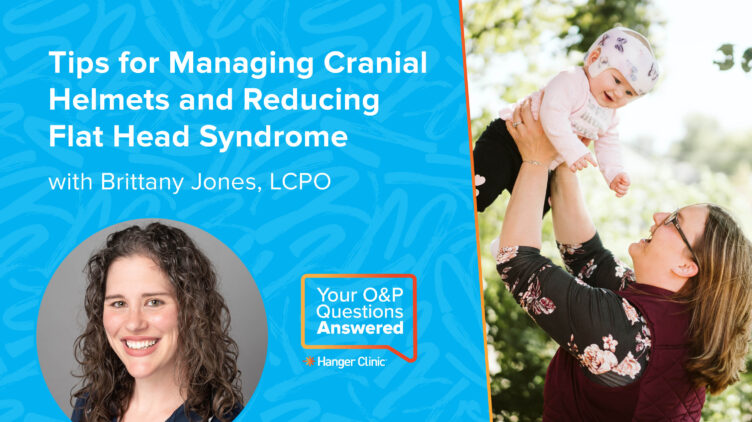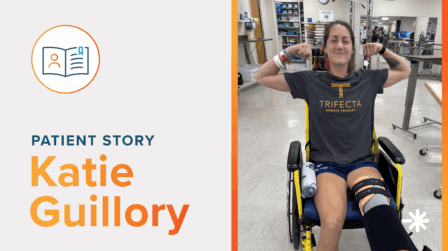Tips for Managing Cranial Helmets and Reducing Flat Head Syndrome

Managing your baby’s cranial helmet treatment and reducing flat head syndrome at home involves staying in close contact with your orthotist, incorporating regular tummy time, and varying your baby’s positions during sleep and play. By following these strategies, you can support your baby’s head shape development and overall well-being.
As a new parent, you want to ensure your baby’s health and development are on the right track. Flat head syndrome (plagiocephaly) and cranial helmet treatments feel challenging, but with the right strategies, you can manage and improve your baby’s head shape effectively. We chatted with Hanger Clinic Cranial Asymmetry Remolding Expert and orthotist Brittany Jones, L/CPO, to uncover tips on managing cranial helmet treatment and reducing flatness at home.
Tips for Managing Your Baby’s Cranial Helmet Treatment
1. Stay in Close Contact with Your Orthotist: It is important to maintain open communication with your orthotist. Keep their contact information handy, including business cards and email addresses. They are there to help and support you through the process. Don’t hesitate to reach out with any questions or concerns. Brittany shared, “Keep your orthotist’s contact information easily accessible in case you have questions. This may be a business card or programming their information in your phone.”
2. One Day at a Time: Adjusting to your baby’s cranial helmet treatment can feel overwhelming. Be patient with yourself and your baby as you adapt to this new routine. Remember, your orthotist and healthcare team are there to support you.
Brittany shared, “Take it one day at a time. It’s hard to change routines. If you have questions or are struggling with helmet wearing, contact your orthotist.”
3. Follow Helmet Wearing Schedule: Ensure your baby wears the cranial helmet for the recommended duration each day, typically around 23 hours. Consistency is key to achieving the best results.
How to Reduce Flatness in Your Baby’s Head Shape at Home
Starting the day you bring your baby home from the hospital, you can use several effective techniques to help reduce flatness in their head shape.
1. Tummy Time: Tummy time is crucial for your baby’s development. It involves placing your baby on their stomach while awake and supervised. This practice helps strengthen their spinal and neck muscles.
“Tummy time is just safe floor play or stomach time that helps babies learn to strengthen their muscles to be able to move around independently. At a very early age, tummy time is often considered belly-to-belly contact with a parent or an adult, which helps keep your baby off the back of their head,” shared Brittany.
2. Repositioning During Sleep: Babies spend significant time on their backs due to sleep recommendations and seated carriers. The American Academy of Pediatrics advises parents to place babies on their backs to sleep to reduce the risk of sudden infant death syndrome (SIDS) and help ensure the safety of their babies. Additionally, many parents use car seats or carriers that keep babies on their backs, adding pressure on the head.
Follow these strategies for alleviating pressure on the same position of the head.
- Change Sleeping Positions: Regularly change the position in which your baby sleeps. “We suggest repositioning baby in their sleeping quarters. Whether that’s a bassinet or a crib, you can change which position your baby is lying in and the direction they are looking so they are not always laying on the same side of their head,” shared Brittany.
- Alternate Head Positions: Turn your baby’s head to a different side each night to prevent constant pressure on one spot.
- Snuggle Time: Babies may be asleep or awake during snuggle time. Lay your baby against your shoulder or in your arms, encouraging them to lift their head and look at you.
3. Engage in Playtime Activities: Incorporate tummy time into playtime by placing your baby on their tummy and helping them prop up on their arms to look at you and toys. Place toys and interesting objects on both sides of your baby to encourage them to turn their head and reach with both hands. This helps develop neck muscles evenly.
4. Varying Holding Positions: Change how you hold your baby during feedings and when carrying them around. This can be done by alternating arms and positions to encourage your baby to look in both directions, promoting balanced muscle development and reducing pressure on the same spot.
By following these tips and maintaining regular communication with your healthcare team, you can effectively manage your baby’s cranial helmet treatment and work towards reducing flat head syndrome at home. With patience, consistency, and support, you can help improve your baby’s head shape and promote healthy growth.
Request a Free Evaluation
With over 200 specialists at more than 260 locations nationwide, Hanger Clinic’s network of Cranial Asymmetry Remolding Experts (CARE Network) helps ensure patients and families receive access to unparalleled care and expertise.
Latest Updates
Subscribe to stay up-to-date on our latest posts.


